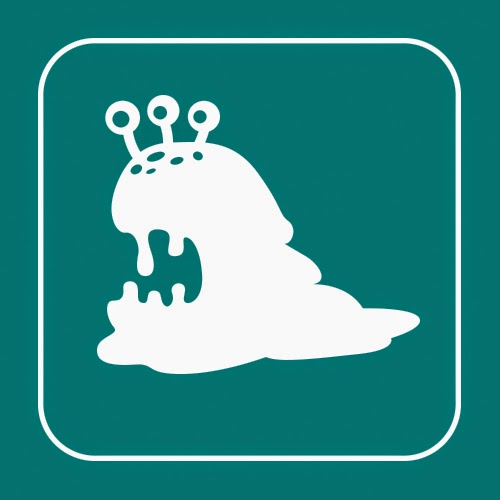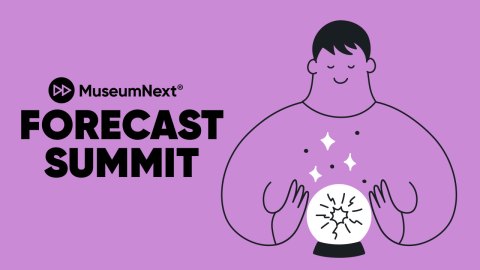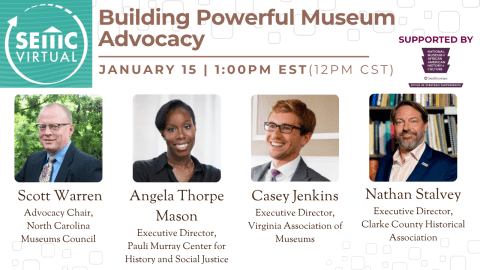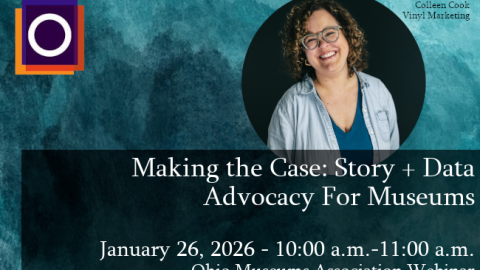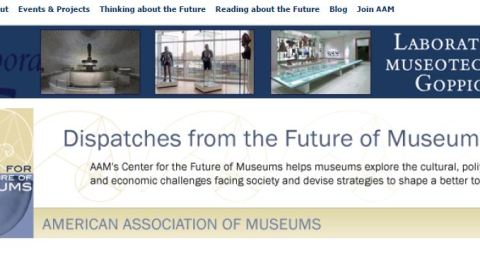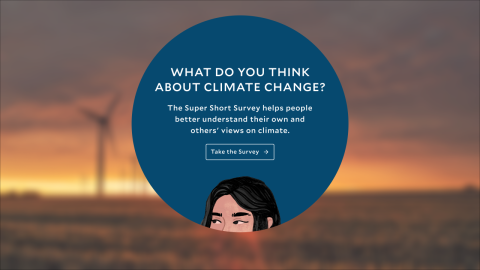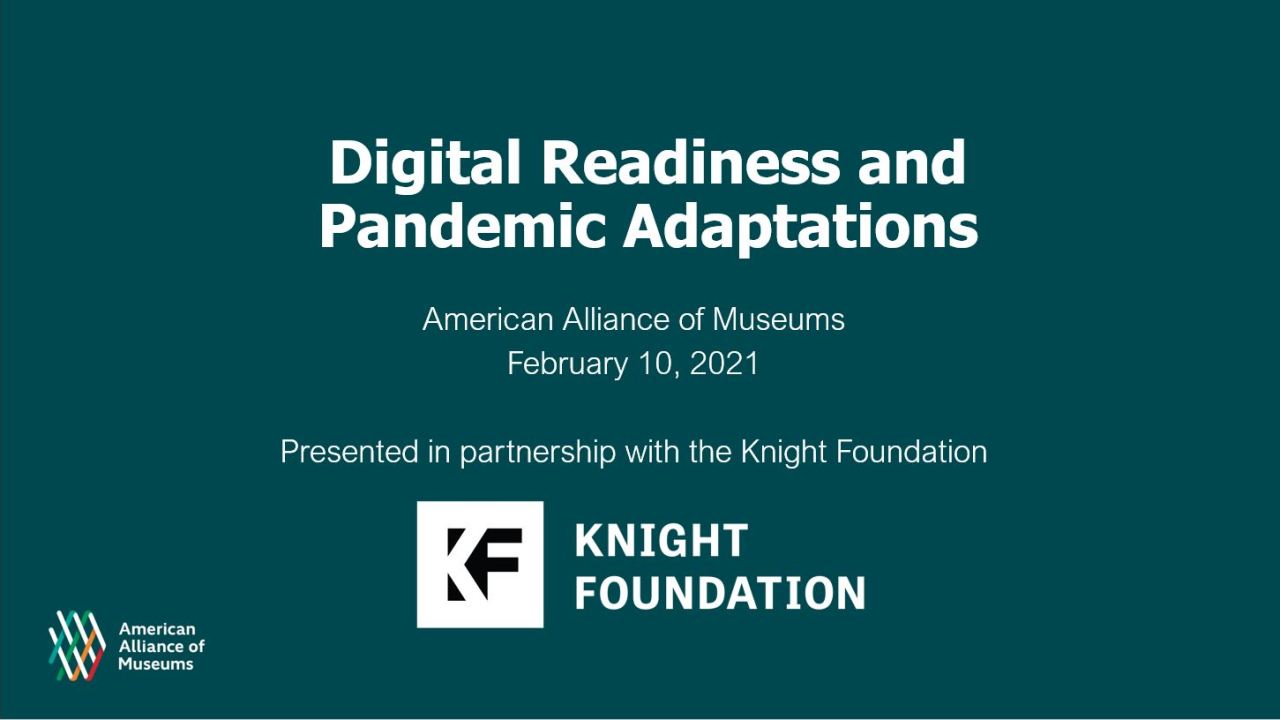
On February 10, 2021, the American Alliance of Museums and the John S. Knight Foundation hosted an online conversation about “Digital Readiness and Pandemic Adaptations.” The webinar recording and transcription are available to AAM members as part of their premium digital content offerings with paid membership.
The webinar was moderated by Elizabeth Merritt, Director for the Center for The Future of Museums. Presenters included Victoria Rogers, Vice President of Arts at the Knight Foundation; Evette Alexander, Director of Learning and Impact at the Knight Foundation; and Neal Stimler, President of Stimler Advantage and Consulting Executive Advisor at the Balboa Park Online Collaborative.
The presenters discussed a field study, “Digital Readiness and Innovation in Museums,” sponsored by the Knight Foundation, conducted by HG&Co, deployed in partnership with the American Alliance of Museums. They also referenced a report supported by the Knight Foundation, “Digital Transformation: An Assessment of Grants Supporting Digital Staff in Museums,” and a white paper from the Balboa Park Online Collaborative, the “GLAMs’ Dynamic Sustainability Platform.”
In today’s post, Koven Smith, the new Senior Director of Arts at the Knight Foundation, joins panelist Neal Stimler to address some of the questions posed by attendees in the webinar’s chat.
Download a free copy of AAM’s latest forecasting report, TrendsWatch: Navigating a Disrupted Future, to access critical questions and a framework museums can use to support their own analysis of digital opportunities.
For small museums that haven’t been able to afford a digital staffer, whether IT or otherwise, what resources can we access to accurately assess our “technical debt” in preparation for building a stronger infrastructure?
(Note: technical debt is debt that is accrued over time as the result of decisions to delay, defer, or neglect the updating or implementation of critical software, hardware, and training. The net effect of accrued technical debt over time is that it hinders the ongoing development and sustainability of technology operations.)
Neal Stimler: One resource available to Libraries and Museums from Catherine Devine, Business Strategy Leader – Libraries and Museums at Microsoft, is the Transformation Assessment Tool. This tool “allows Libraries and Museums to self-assess their progress on their digital transformation journey, their target progress, and considerations for strategies to consider to move towards those goals.” Learn more from Catherine Devine’s LinkedIn Pulse post.
Additionally, consultants can help an organization pinpoint its digital transformation and guide the organization to undertake this mission-critical work. The American Alliance of Museums Museum Marketplace may be a place to find a consultancy company that can help you.
Koven Smith: In addition to the resources that Neal mentions, I would also point to our own “Digital Readiness and Innovation in Museums” report, which contains a maturity matrix that can help an organization to self-assess its own level of technical debt. I would also recommend checking out the Museum Learning Hub, which is funded by IMLS and run by the six U.S. regional museums associations. There are a lot of practical training resources and tools in there that can help institutions build up their technical fluency and address technical debt. While less domain-specific, TechSoup also offers helpful training designed to address digital literacy and planning for a non-profit organization.
How much, if at all, are you seeing collaboration across museums as a way of increasing an individual museum’s digital capacity? (I.e., shared learnings, tools, even positions.)
Koven Smith: Funders like Knight and others may periodically convene grantee cohorts so that participants in a grant program can share their learnings with each other, as we have done with our Arts + Tech fellows and participants in our museum staffing grant program. In some cases, members of these cohorts remain in touch even after the grant has concluded, and our hope is always that these cohorts blossom into longer-term collaborative endeavors.
Operational collaborations are unfortunately less common than one might hope, however. Apart from consortia-based research projects like the American Art Collaborative, there aren’t many examples of institutions increasing capacity through collaboration. Given that the public’s appetite for digital content from museums appears to have increased significantly during the pandemic, more examples of this kind of collaboration seem likely to emerge. There may be a role for larger membership organizations to play in encouraging this kind of collaboration; CultureSource‘s re-granting initiatives in Southeast Michigan, and the previously-mentioned Museum Learning Hub, are successful examples of how this could potentially work.
Neal Stimler: The Balboa Park Online Collaborative, in San Diego, California, is an example of how a group of museums can leverage shared services to support digital capacity. In the United States, except for some government and private institutions with multiple locations, most museums act as independent not-for-profit institutions competing for customers’ attention, time, and money. Many fronts continue to challenge the future of museums. New or refreshed business models are needed for the long-term self-sustainability and relevance of museums.
Private for-profit museums, experiums, video games, augmented reality, mixed reality, virtual reality, and websites are market-based platforms that are more accessible, consumable, and relatable to customers with digital-first or hybrid approaches. It would be encouraging and inspiring to see groups of regional or topical museums coming together to form new business entities to not only share resources but use them wisely and profitably to support their missions and customer experience. I would be glad to be a part of building such pragmatic solutions for the sector with commercial partners and institutions.
Are most of decisions about digital strategy and implementation made internally, or are institutions looking to external sources (peers, partners, consultants) for guidance?
Koven Smith: We are seeing a combination of these approaches in both the research we’ve done and the grantees we’ve worked with. Some institutions are fortunate enough to have one or more digital positions on staff, and museum leadership will often look to the people in these positions for counsel on how (or whether) to proceed with their digital efforts. Institutions with dedicated digital positions remain the exception rather than the rule, however. In these cases, museum leaders will often reach out to peer institutions, or sometimes a funder they already have a relationship with, for advice or guidance. These peers or funders may suggest appropriate consultants to partner with the institution for the initiative at hand. For Knight’s part, we will generally try to point an institution towards consultant or consultants who have clear domain expertise (in this case, direct experience working in museums) in addition to more generalized technical skills.
Neal Stimler: Museum professionals can and should utilize a variety of resources when exploring digital strategy. Online events, publications, and workshops are good places to go for information that can provide an initial framework for your organization’s journey or give insight into a specific area of interest. Depending on your organization’s size, you may have an entirely in-house digital team, a digital workgroup spread across the organization, contracted agencies, or work with external consultants regularly. Peer networks, both informal and formal like professional associations, play a role in working through digital readiness through collegial support. The key is to know how to optimize and best utilize this ecosystem of resources at the right time and depth level.
It can be challenging to know when to utilize consultants to help your organizational or digital strategy needs. There are optimal moments to engage consultants in your project timeline. With proven practical experience and future-oriented capabilities, consultants can help an organization set direction at the outset of an initiative through listening and visioning work that brings a project team together. Consultants can be bridges between the board, executive, and staff levels of an organization. It can be especially beneficial to use consultants to help an internal team discover and explore the field’s state, new trends, or lessons learned across and outside the industry and think outside of their normal work habits and processes. These are strategic uses of consultant support.
Consultant expertise can also be applied more tactically to help an organization as hands-on collaborators to solve a specific workflow, technology, or service problem in a given timeline. These are scenarios where a few experienced extra hands and support can help implement a solution that benefits your organizational needs, and most importantly, customers. For example, you might hire consultants to deliver a software migration project for collections management, customer relationship management, membership, or ticketing system.
With consultants, the organization is paying a premium for expertise and support. An organization also needs to take responsibility itself to ensure that desired outcomes for the engagement are achieved when consultants are engaged. When working with consultants, you and your colleagues should be ready to work and succeed together with the serious investment of time, human capital, and resources. Call consultants when you have committed to the next level and are moving on doing the work.
How do you all feel about Augmented Reality (AR)?
Neal Stimler: Elizabeth Merritt and I have been immersed in the exploration of augmented reality (AR) and experiential technologies for some time. In 2015 we collaborated with GuidiGo to present a Google Glass experience at the American Alliance of Museums Expo Hall for conference attendees. (You can read Part I and Part II of that experience on the Center For the Future of Museums blog.) There has been continued growth in augmented reality and new applications largely in the handheld and mobile context as accessible to the largest number of consumers.
A notable example of an augmented reality experience: In 2018, The Morgan Library produced an AR tour of its amazing building on Madison Avenue in New York City with GuidiGo and MediaCombo. This tour brought new contexts and perspectives to the princely library through digital audio, images, and animations matched to the building’s experience in real time and space. A video also demonstrates and now archives the content experience of augmented reality at The Morgan Library.
In 2019, I collaborated with Charlie Fink to write a survey of AR in Museums that appeared in his book Convergence. With Google’s ARCore and Apple’s ARKit, content production with augmented reality has become easier for agencies and institutions. Google Arts and Culture and Sketchfab are two major platforms where augmented reality experiences can be engaged. New and notable campaigns in augmented reality done with cultural institutions in 2021 include Verizon and The Metropolitan Museum of Art’s “The Met Unframed” and Snapchat and LACMA’s collaboration on “Monumental Perspectives.”
Increases in open access that support unrestricted commercial reuse and internationally operative legal terms like the Creative Commons Zero Public Domain Dedication, as well as the enhanced availability of 3D models, have played a significant role in bringing museum content to new audiences in partnerships with corporate and mainstream technologies wherever they are. From Google Glass, heads-up display experiences have evolved to new applications and industries. Microsoft Hololens is a powerful technology that has already engaged and shaped new immersive experiences with museums, such as its Mont-Saint-Michel model. More players have come into an expanded range of digital experiences and a more diverse marketplace, with new concepts like mixed reality.
Charlie Fink and Cathy Hackl, two thought leaders I appreciate and follow closely, have articulated our next stage of immersive techno-reality as the Metaverse, “a future iteration of the internet made up of persistent, shared, 3D virtual spaces linked into a perceived virtual universe.” Hackl writes, “the Metaverse is a persistent, digital reality comprised of vast amounts of information and activity that stays anchored where you place, even when you aren’t there.” Hackl foresees, “The physical world we live in becomes machine-readable, clickable, and searchable. There will be new interfaces and new ways to navigate and create content. We will create new lexicons and even new architectures for our digital selves and the digital world around us.” The Metaverse will be driving new communications, content, and marketing strategies for all industries, including museums.
Success with augmented reality, and other coming immersive technology experiences, depends on a museum having itself already undertaken serious investment, effort, and a systematic approach to digitizing its collections, programs, and services. That said, any museum can course correct and start moving in digital-first directions today. Among the insights the COVID-19 pandemic and ongoing public health and safety crises have demonstrated is digital transformation’s absolute urgency. Invest your institution’s expertise and resources immediately into rapid and sustainable digitization. Bring your audiences more accessible experiences with measurable and higher-performing impact at scale in the emerging Metaverse.
Koven Smith: AR is definitely a potential growth area for museums. When Knight ran an open call for ideas focused on arts & technology in 2018, nearly a quarter of the applications we received featured either AR or Virtual Reality (VR), which led to us funding several VR and AR initiatives, most notably the Lumin project at the Detroit Institute of Arts, and five mixed-reality projects we funded through a series of recent immersive technology grants. There’s a tremendous amount of promise in AR for museums, particularly when issues of accessibility and translation are taken into account.
That said, the platforms on which museums build their AR experiences are subject to market forces. This can mean that a carefully-crafted museum AR experience can collapse when the underlying platform is changed or retired altogether, as happened in 2018 when Google discontinued Project Tango. I am hopeful that this will be less of an issue now that AR is natively “baked in” to the mobile OS (with ARKit for iOS and ARCore for Android), but as with any museum experience heavily dependent on technology built by others, it remains a risk that should be taken into account.
